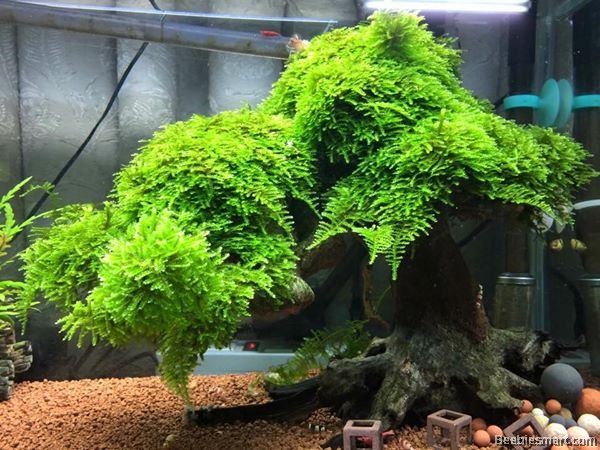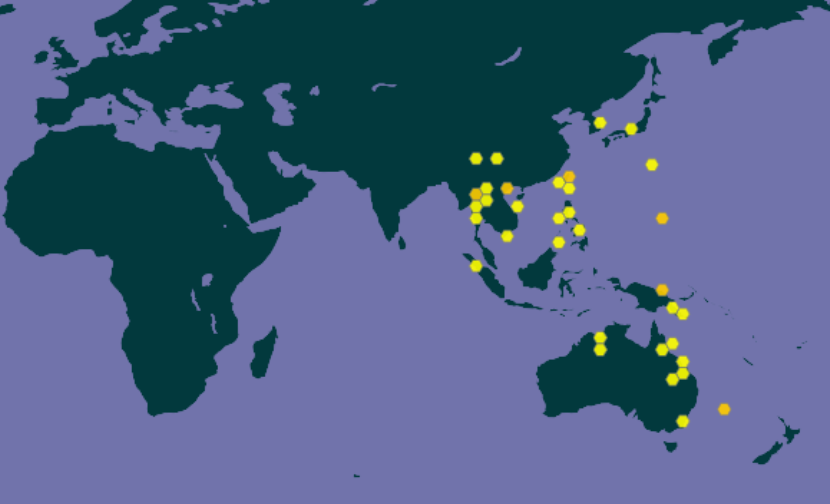By Alastair Culham
We’ve already had some excellent moss blogs in past #AdventBotany years but there are still new species available. Today we have a moss from Australia through southeast Asia, and in to Arabia, Vesicularia montagnei (Schimp.) Broth. which is widely use in aquaria for aquascaping. Its name comes simply from the rather Christmas tree look of the branches.

It’s one of several mosses that grow on rocks in streams and this one is usually submersed for only part of the time (Liu et al. 2013). However, in an aquarium setting it seems to grow well when permanently underwater (Tank Addict, 2020).
Where does Christmas moss grow?
If you browse the internet you’ll get a range of information on the distribution of this species and a lot of mentions of Brazil, however I can’t find any evidence for natural ocurrence in Brazil. Most of the reported distribution is in the far East from Japan and Korea in the North, through China and Malesia south to the northern regions of Australia. There are also mentions of the species in India although the India Biodiversity Portal has no records for the species andhas a page ready for the first record! Digging deeper I found a record for West Bengal (Singh and Ghosh, 2007).

(https://www.gbif.org/species/5838386)
The GBIF Secretariat (2021) map is the most comprehensive source of distribution data but is not the whole picture. Stoneburner et al. (1993) report a broader distribution in northern Australia and Kürschner and Ochyra (2014) further expand the known range to the Arabian peninsular!
Polonium-210
This moss does not just look pretty in an aquarium. Polonium-210 was used to kill the Russian dissident and ex-FSB officer, Alexander Litvinenko in 2006 (McFee and Leikin, 2009). It is a hugely toxic element that releases alpha particles during radiactive decay. In the study “Deposition Assessment of Anthropogenic Airborne 210Po And 210Pb in the Mosses and Surface Soil at the Vicinity of a Coal-Fired Power Plant”, Nita and Abdul (2014) demonstrated that this moss, among three others studied, could accumulate levels of 210Po at more than twice the background concentration in the soil. Mosses are not just crucial carbon accumulators they also mop up a range of other compounds from the environment.
Next time you are thinking of de-mossing your lawn think again.
References
Kürschner, H. and Ochyra, R., 2014. Novelties in the moss flora of Oman, Saudi Arabia and Yemen, including the most outstanding Vesicularia montagnei (Bél.) Broth.(Hypnaceae). Cryptogamie, Bryologie, 35 (1), pp.93-97.
Liu, B., Tian, Q.J., Jiang, Y.D. And Lei, T., 2013. Habitat and Sexual Reproductive System in Vesicularia Montagnei, a Rock Outcrop Moss in a Stream. Journal of Jishou University (Natural Sciences Edition), 34 (4), p.89.
McFee, R. B.; Leikin, J. B., 2009. “Death by polonium-210: lessons learned from the murder of former Soviet spy Alexander Litvinenko”. Seminars in Diagnostic Pathology. 26 (1): 61–67
Nita, S.A.B. and Abdul, K.I., 2014. Deposition Assessment Of Anthropogenic Airborne 210 Po And 210 Pb In The Mosses And Surface Soil At The Vicinity Of A Coal-Fired Power Plant. International Nuclear Information System (INIS) Report , INIS-MY–2015-012
Singh, S.K. and Ghosh, J.P., 2007. Bryo-diversity in Indian Botanic Garden, Howrah, West Bengal. Nelumbo, 49(1-4), pp.155-164.
Stoneburner, A., Wyatt, R., Catcheside, D.G. and Stone, I.G., 1993. Census of the mosses of Western Australia. Bryologist, pp.86-101.
Tank Addict, 2020. Christmas Moss Care, Propagation, & Issues https://tankaddict.com/christmas-moss/
